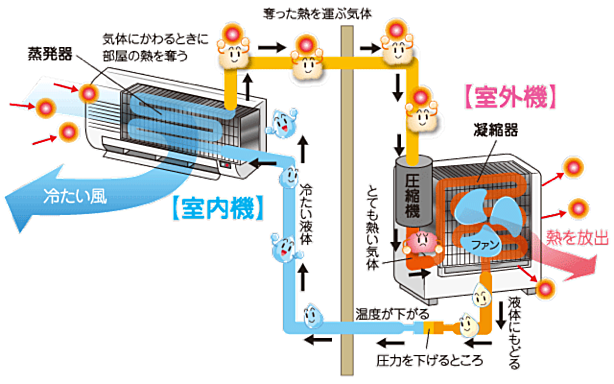Air conditioners, refrigerators, and heat pump water heaters are all driven with the same operating principle. Figure 1 shows the state that the air conditioner is doing the air conditioning as an example. First of all, the operating principle is explained based on this operation state. The evaporator as a heat exchanger, the condenser, the compressor as a rotary machine driven by external power, and the expansion valve are the basic components. The interior unit has a built-in evaporator, and the outdoor unit has a condenser, compressor, and expansion valve. These components are connected by a pipe and the refrigerant flows and forms a heat pump cycle (also known as a refrigeration cycle). The refrigerant evaporates at about 5° even at a pressure state higher than atmospheric pressure, and it becomes the one that it wants to liquefy even about 30°.
Refrigerant vapor (1) at low temperature and low pressure flows into the compressor and is pressurized here, resulting in high temperature and high pressure. The power required to drive this compressor is the driving source of the air conditioner.
High-temperature and high-pressure refrigerants that flow out of the compressor flow into the condenser. In condensers, high-temperature-side fluids (outside air) have lower temperatures than refrigerant, so heat is transmitted from the refrigerant to the high-temperature side fluid, the refrigerant is cooled, and the refrigerant gas is condensed (liquefied). High-temperature side fluids are heated with heat.
The high-temperature and high-pressure condensate (3) that drains the condenser passes through the expansion valve. The expansion valve is a small hole, and when it passes through here, the refrigerant becomes low temperature and low pressure. This is just like being cooled when the fluid is released from a high pressure inner can to the low outside.
This low-temperature low-pressure refrigerant (4) flows into the evaporator. In the evaporator, heat moves from the low-temperature side fluid to the refrigerant by performing heat exchange with the low-temperature side fluid (in this case, indoor air) where the refrigerant of this low temperature and low pressure is higher than the temperature.
As a result, the refrigerant is heated, evaporated, and cools the low-temperature side fluid by the latent heat to obtain heat. The cycle is established by repeating this. During heating, by switching the internal flow direction, the heat exchanger of the outdoor unit plays the role of the condenser in the evaporator and the heat exchanger installed in the indoor unit. As a result, the high temperature air which got heat in the indoor unit circulates in the room. In the heat pump water heater, the hot water is taken out by the heat of water.

www.athome.tsuruga.fukui.jp